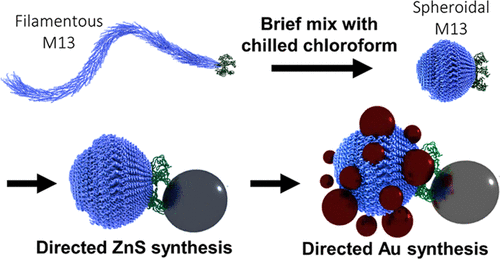当前位置:
X-MOL 学术
›
ACS Appl. Nano Mater.
›
论文详情
Our official English website, www.x-mol.net, welcomes your feedback! (Note: you will need to create a separate account there.)
Bifunctional M13 Bacteriophage Nanospheroids for the Synthesis of Hybrid Noncentrosymmetric Nanoparticles
ACS Applied Nano Materials ( IF 5.9 ) Pub Date : 2020-11-05 , DOI: 10.1021/acsanm.0c01876 Joshua M. Plank 1 , Zaira Alibay 2 , Tam-Triet Ngo-Duc 2 , Michelle Lai 3 , Eleanor A. S. Mayes 2 , Elaine D. Haberer 1, 2
ACS Applied Nano Materials ( IF 5.9 ) Pub Date : 2020-11-05 , DOI: 10.1021/acsanm.0c01876 Joshua M. Plank 1 , Zaira Alibay 2 , Tam-Triet Ngo-Duc 2 , Michelle Lai 3 , Eleanor A. S. Mayes 2 , Elaine D. Haberer 1, 2
Affiliation

|
Noncentrosymmetric nanostructures are composed of two different materials displayed on spatially distinct surface regions. These nontrivial building blocks facilitate self-assembly of hierarchical nanostructures with increased complexity and support cooperative material behaviors. The arrangement of M13 bacteriophage structural proteins within its capsid creates a promising monodisperse and readily modifiable template for these low-symmetry nanomaterials. Here, a 9-mer ZnS-binding peptide was inserted into the p3 minor coat protein (capsid tip) of an M13 bacteriophage with Au-binding motif fused to its p8 major coat protein (capsid body). Multiple vortex/rest cycles with chloroform were used to convert this bifunctional, Au/ZnS (p8/p3)-binding phage from filament to spheroid. The shape transformation was studied with transmission electron microscopy, circular dichroism spectroscopy, and fluorescence spectroscopy. The effects of the p3 peptide fusion and conversion temperature were evaluated. Compared to the Au-binding phage without a p3 peptide fusion, the insertion of the ZnS-binding motif increased spheroid size, molar ellipticity loss, and intrinsic fluorescence quenching. Reduced temperature (0 °C) within early transformation cycles diminished spheroid polydispersity and increased agglomeration resistance. In addition, Au/ZnS-binding spheroids retained peptide motif affinity and relative placement of the p3 and p8. Site-specific synthesis of ZnS and Au on the p3 and p8, respectively, produced noncentrosymmetric hybrid metal/semiconductor nanostructures. This work highlights the effect of a p3 mutation on filament to spheroid transformation as well as the importance of temperature in producing a robust scaffold for inorganic material synthesis. Finally, the manufactured bifunctional M13 spheroids were used for the biodirected synthesis of noncentrosymmetric nanoparticle assemblies demonstrating the potential for heterojunction formation.
中文翻译:

双功能M13噬菌体纳米球体用于混合非中心对称纳米粒子的合成。
非中心对称纳米结构由在空间上不同的表面区域显示的两种不同的材料组成。这些非平凡的构建基块促进了具有增加的复杂性的分层纳米结构的自组装,并支持了协作的材料行为。M13噬菌体结构蛋白在其衣壳内的排列为这些低对称纳米材料创造了一种有前途的单分散且易于修饰的模板。在此,将9聚体ZnS结合肽插入具有融合有其p8主要外壳蛋白(衣壳体)的Au结合基序的M13噬菌体的p3次要外壳蛋白(衣壳尖端)。使用氯仿的多个涡旋/休止循环将这种双功能的Au / ZnS(p8 / p3)结合噬菌体从细丝转化为球状。用透射电子显微镜,圆二色光谱和荧光光谱研究了形状转变。评估了p3肽融合和转化温度的影响。与没有p3肽融合的Au结合噬菌体相比,ZnS结合基序的插入增加了球体尺寸,摩尔椭圆度损失和固有荧光猝灭。在早期转化周期内降低温度(0°C)会降低球状体的多分散性并提高抗结块性。此外,Au / ZnS结合球体保留了肽基序亲和力以及p3和p8的相对位置。在p3和p8上分别进行ZnS和Au的位点特异性合成,产生了非中心对称的杂化金属/半导体纳米结构。这项工作强调了p3突变对长丝到球状体转化的影响,以及温度在生产用于无机材料合成的坚固支架中的重要性。最后,将制造的双功能M13球体用于非中心对称纳米粒子组件的生物定向合成,证明了异质结形成的潜力。
更新日期:2020-11-25
中文翻译:

双功能M13噬菌体纳米球体用于混合非中心对称纳米粒子的合成。
非中心对称纳米结构由在空间上不同的表面区域显示的两种不同的材料组成。这些非平凡的构建基块促进了具有增加的复杂性的分层纳米结构的自组装,并支持了协作的材料行为。M13噬菌体结构蛋白在其衣壳内的排列为这些低对称纳米材料创造了一种有前途的单分散且易于修饰的模板。在此,将9聚体ZnS结合肽插入具有融合有其p8主要外壳蛋白(衣壳体)的Au结合基序的M13噬菌体的p3次要外壳蛋白(衣壳尖端)。使用氯仿的多个涡旋/休止循环将这种双功能的Au / ZnS(p8 / p3)结合噬菌体从细丝转化为球状。用透射电子显微镜,圆二色光谱和荧光光谱研究了形状转变。评估了p3肽融合和转化温度的影响。与没有p3肽融合的Au结合噬菌体相比,ZnS结合基序的插入增加了球体尺寸,摩尔椭圆度损失和固有荧光猝灭。在早期转化周期内降低温度(0°C)会降低球状体的多分散性并提高抗结块性。此外,Au / ZnS结合球体保留了肽基序亲和力以及p3和p8的相对位置。在p3和p8上分别进行ZnS和Au的位点特异性合成,产生了非中心对称的杂化金属/半导体纳米结构。这项工作强调了p3突变对长丝到球状体转化的影响,以及温度在生产用于无机材料合成的坚固支架中的重要性。最后,将制造的双功能M13球体用于非中心对称纳米粒子组件的生物定向合成,证明了异质结形成的潜力。



























 京公网安备 11010802027423号
京公网安备 11010802027423号